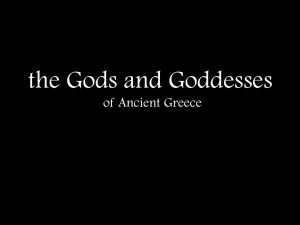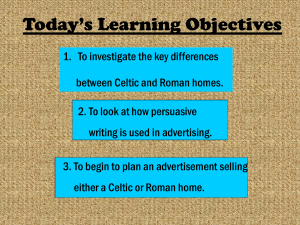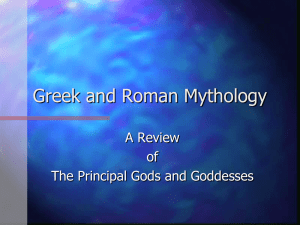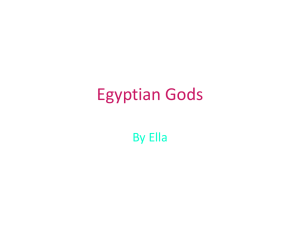Romanisation and Aquae Sulis Part 1
advertisement
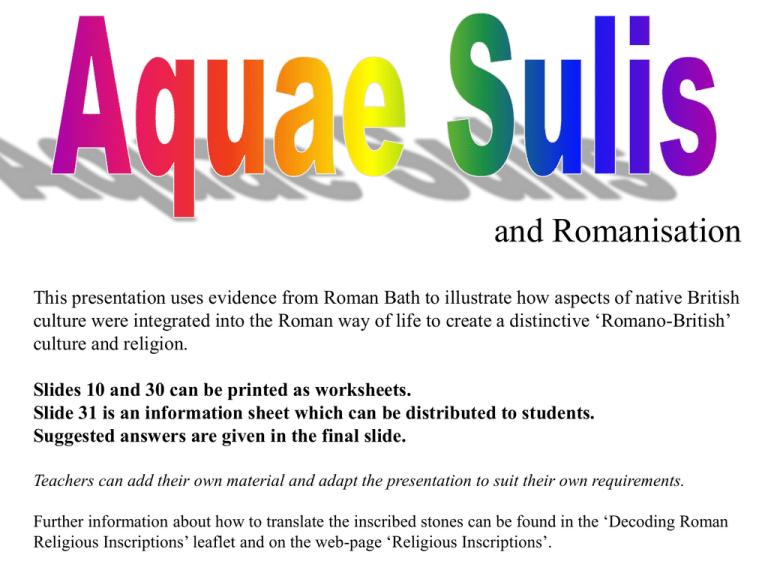
and Romanisation This presentation uses evidence from Roman Bath to illustrate how aspects of native British culture were integrated into the Roman way of life to create a distinctive ‘Romano-British’ culture and religion. Slides 10 and 30 can be printed as worksheets. Slide 31 is an information sheet which can be distributed to students. Suggested answers are given in the final slide. Teachers can add their own material and adapt the presentation to suit their own requirements. Further information about how to translate the inscribed stones can be found in the ‘Decoding Roman Religious Inscriptions’ leaflet and on the web-page ‘Religious Inscriptions’. PART ONE: The naming of Aquae Sulis and the goddess worshipped there. What is ‘Romanisation’? • How did the Romans achieve ‘Romanisation’? • How did they make the native Britons want to be like Romans? • How did they let the Britons keep some of their own culture and combine it with Roman culture? • How did ‘Romano British’ religion develop as a specific version of Roman religion? • What characteristics of Roman and Celtic religion made this fusion possible? • How did Romanisation enable the Romans to unify multicultural societies throughout their Empire? Bath Aquae Sulis This reconstruction drawing shows what the Roman town looked like, with all the usual features inside a town wall: forum, theatre, temples, baths … instead of the Celtic roundhouses which the native Britons had been used to. Just imagine all the new skills which British workmen would learn from the experts brought in from Italy: Stone: quarrying, carving. We know the names of two stonemasons based at Bath! Bricks and tiles: firing and new building techniques Concrete: for domes, vaults and arches. Lead: mining, pipe-making, sealing the linings of baths. Metalwork: for e.g. keys, locks, weights and measures. Pewter, leather, pottery, glassware. Plaster, stucco: for wall decoration. Hypocaust: underfloor hot-air central heating. Mosaics: making tesserae, artistic designs. The museum has more evidence of individuals and the way they worked in Roman Bath examples of makers’ marks, keys for lifting blocks of stone, plasterwork roughened to take a top decorative finish, a piece of pottery with a name scratched on it MARTINI = “Martinus’s” Did Martinus scratch his name on this dish to show that it belonged to him? - and even a possible reminder of a watch-dog: paw-prints preserved in clay! This assumes that there was a desire for town life, with its accompanying social structures and Town Council, replacing old tribal loyalties. Throughout their Empire the Romans did indeed foster this change in attitude, so that wherever a traveller went in the Roman world he would find exactly the same kinds of cities with the same buildings and an inclusive ‘Romanised’ culture. .. but the special thing about Bath is that a spring of hot water bubbles up near the river. Hot spring water – the Roman goddess of hot springs was Minerva. PROBLEM : British (Celtic) religion was not the same as Roman religion. How did the Romans build their temple without offending the Celtic Britons? The Celts worshipped a goddess called Sulis or perhaps a god called Sul here. Roman Bath Aquae Sulis Perhaps Minerva liked to be called Sulis in this particular place? The Roman name for the town: ‘Waters of Sulis’ gives honour to the Celtic tradition. Look at the Temple and Baths in the centre of the town. The next slide is designed to be used as a worksheet if it is printed in advance and the information sheet (slide 31) can be distributed at the end of the presentation. Keep these sheets carefully because they will be needed for Romanisation Part 2. Roman religion : What do you know about ……? Fill in as much as you can after slide 8, then discuss your answers and try to add more points to your original list. 1. Roman gods and goddesses? Name ……………………………….. Using the information sheet, complete the following: 1. Identify 3 interesting facts about Roman religious ceremonies. 2. Roman religious buildings? 2. Identify 3 interesting facts about Minerva. 3. Roman religious ceremonies (including sacrifices)? 3. Where did the Celts worship? 4. Why do you think the Romans wrote damning propaganda about the Druids? 5. Who is Sulis? Next: fill in the second section when you have seen more of the slides. The spring of sacred water is in the corner of the sacred temple precinct, but it is also linked to the Baths complex on the right so that the excess water could be used as part of the normal Roman bathing experience. A typical Roman temple, raised up with an imposing flight of steps. The sacrificial altar would be in front of the temple and there would be a large statue of the god or goddess inside the temple, where only priests were permitted to go. A Haruspex would examine the organs of sacrificed animals and use them to interpret the wishes of the gods and prophesy the future. A typical Celtic temple. The Celts did not have temples! They would leave the sacred spring as it was and just meet there to give offerings to its god or goddess. Archaeological remains suggest some sort of platform by the side of the marsh. Minerva: Roman goddess of War, Wisdom and hot, healing springs. The Romans had already adapted Greek mythology and religion to suit their own gods and goddesses: Minerva was the Roman equivalent of the Greek goddess Athena. You can see the Gorgon Medusa’s snaky-haired head on Minerva’s breast-plate on this little altar. Notice the owl sitting on Minerva’s shield. ‘Relief’ carving like this is typically Roman: not quite 3-D but raised from a flat background. This lovely gilt-bronze head is all that is left of a (slightly larger than) life-sized statue which probably stood in the temple. It is very good quality – a statue in the Classical Greek and Roman style. Small rivet-holes hidden in the hair show where her helmet would have been attached. But what about Celtic religion? There are very few examples of Celtic carvings from before Roman times. They may have worshipped a water-god. They sometimes worshipped carved heads and possibly animals. The Celtic style is more primitive as you can see on this little altar to three Mother Goddesses made in the Roman ‘relief’ style. Decoration of a water god on a silver dish from Mildenhall – notice his Celtic moustache and the dolphins in his hair. The goddess worshipped at Bath was known as …….. ……. Sulis Minerva. Here are some ‘paterae’ –dishes thrown into the spring as presents for the goddess (DEA). You can see her name carved on the handles. Latin has no word for ‘for’ – but instead the spelling of the goddess’s name changes: deae Suli Minervae = for the goddess Sulis Minerva. These words are in the DATIVE case. Here is a votive altar dedicated as a gift to Sulis Minerva by someone called Sulinus. Can you read the name on the first three lines of this inscription? Some of the letters are written backwards, ‘I’ is often carved superscript, and there are many ligatures (joined letters). DEA SULIS MINERVA Latin has no word for ‘To’ but instead changes the endings of the words: deae Suli Minervae = ‘To the goddess Sulis Minerva’. These words are in the DATIVE case. To the goddess Sulis Minerva, Sulinus, Maturus’ son (FILius) V S L M is short for: VOTUM SOLVIT LIBENTER MERITO happily and deservedly kept the promise he had made (i.e. to give this present to the goddess) Sulinus had obviously promised to give this offering if Sulis did something for him. The second line of this stone gives us the name of a Roman haruspex at the temple – beautiful ligatures! (This is the technical term for joined letters). D D is a formulaic inscription: ‘dono dedit’ = gave this as a gift. We can assume that a statue of the goddess probably stood next to this dedication stone. His name: LUCIUS MARCIUS MEMOR The asymetrical positioning of ‘HARVSP’ suggests that ‘VSP’ was added later, possibly because nobody in Britain knew what a Haruspex was or that ‘HAR’ was an abbreviation for it! It is interesting to see that a senior representative of Roman religion calls the goddess Sulis rather than ‘Sulis Minerva’ or even ‘Minerva’: her Roman name. Gods were also asked to punish their worshippers’ enemies. This lead alloy curse tablet is requesting Sulis to make as liquid as water whoever has stolen ‘my vilbia’. ‘vilbia’ is an unusual word and no-one is quite sure what it means! Each word is written in reverse order: [I]UQ IHIM MAIBLIV TIVALO[V]NI QUI MIHI VILBIAM INVOLAVIT whoever has stolen my vilbia One of the curses from the spring is written in a different language and it is possible that it is the only example of a Celtic curse to survive. More objects thrown into the spring as offerings. Just like today – people threw coins into the spring! Other objects are more puzzling, such as the tin mask at the back. Does it have some significance in Celtic or Roman religion or is it just a precious gift? This pedimental sculpture on the front of the temple would have been painted in bright colours. We should expect all the features to be very symbolic. What does the central roundel show? male or female? snakes? wings? water god? Gorgon? The next slide is designed to be used as a worksheet if it is printed in advance. 1. 2. Draw arrows to show where each feature is located. Using two different coloured pens, identify the Celtic and Roman features of as many parts of the pediment as you can (not just the pictured sections!) Temple Pediment at Aquae Sulis Which features are Roman and which are Celtic? Name ……………………………….. Try this without looking at the reference sheet first, discuss your ideas and then look at the sheet for more clues. Explain carefully what the different features represent and if you think that some are ambiguous or a mixture, explain why. Even archaeologists do not know all the answers! WORKSHEET Roman religion : lots of evidence, both written and sculptural. Celtic religion : hardly any evidence from before Roman N.B. Most of the gods in the traditional Roman pantheon were associated with Greek deities and shared the Greek mythological tradition. times. All our written evidence is from the Romans! Various Celtic gods, some of whose names we are not sure of: Sulis, Nemetona, Rosmerta (often depicted holding a bucket-like container and accompanying the Roman god Mercury), Loucetius, Lenus, Ancamma. 3 Mother goddesses, called Suleviae in parts of Germany. 3 ‘Genii Cucullati’ – little hooded figures wearing a type of cloak which was apparently made in Britain. Jupiter, King of Gods, associated with a thunderbolt; Juno, Minerva, Apollo, Venus, Diana, goddess of hunting, also known as Luna, the Moon goddess; Mercury, god of Trade and also the messenger of the gods; Mars, god of War, Aesculapius god of healing. Neptune was god of the sea, but there was a minor god called Triton who is often depicted using a shell as a musical instrument. Romans liked the people in their Empire to worship the ’numen’ or divinity of The Celts may have worshipped heads. Several carved heads have been their Emperors and to acknowledge their deification after death. This was a civic found but they may not have been made before Roman times. duty as well as a religious one. They may also have worshipped the power of animals. They also worshipped personifications: e.g. Virtue, Health, Duty. They had no temples, preferring to worship at sacred places, like hot springs. Temples : based on Greek temples, with We know very little about their priests called Druids, but the Romans - impressive triangular ‘pediments’ at the front, with intricate relief sculpture exterminated them and wrote damaging propaganda about them which is carefully designed to fit the shape and formal motifs like circlets of leaves. unlikely to be true. Druids used to inspire respect and nationalistic feelings - huge pillars topped with finely decorated ‘Capitals’ and would not contribute to the Romanisation of religion. Sculptures could be 3-D or relief carvings on a flat backgound. The style was sophisticated and lifelike. They did not make representations of their gods until Roman times, when Ceremonies took place outside the temple, sometimes sacrificing animals. A Haruspex would look at the internal organs of these animals to interpret the wishes and predictions of the gods. People asked the gods to help them and promised to give them presents in return : that is why there are lots of inscribed ‘votive’ altars and offerings of all kinds at sacred sites. See the Decoding leaflet, the Webpage and other resources for help with understanding these inscriptions. Sometimes the gods were asked to punish people and that is why curse tablets are often found at religious sites. Many of these have been found in the sacred spring, written in a cursive script and often with each word written backwards. See the interactive Museum displays to understand these better. Minerva (Like the Greek goddess Athena) Goddess of War, Wisdom and hot springs. Her symbol was an owl, and a banded globe also signifies wisdom. When Medusa, the snaky-haired gorgon, had been killed by Perseus, he cut off her head and took it to Athena, who put it onto her own armour. One of her names is Nike (Victory), often shown as a winged goddess. INFORMATION SHEET TO BE PRINTED AND USED WITH ROMANISATION PARTS 1 & 2 they started to make little altars with relief sculptures on them. Male gods were often shown with horns on their head, presumably to emphasise their power. From other artefacts we have (such as weapons and jewellery) we know that the Celts liked to incorporate beautiful swirling patterns into their art, making stylised patterns rather than lifelike images. Sulis - the Celtic name for the goddess worshipped at Bath. If the main Celtic deity at Bath had been a god called Sul, perhaps ‘Sulis’ can mean ‘daughter of Sul’. We don’t know. As Roman Britain was a multicultural society, it is very difficult to know which gods originated in Britain and which came from other areas. Other religions : Roman soldiers came from all parts of the Empire and would bring their own gods with them – eg. the Egyptian goddess Isis and the Persian god Mithras, a favourite god of soldiers. Christianity was not tolerated by the Romans because Christians refused to acknowledge other gods or worship the Emperor as a god ( – treason!) until it was made the official religion of the Empire in the 4th Century. APPENDIX Possible answers for Pediment worksheet. Celtic features in red and Roman features in blue. Temple and Pedimental sculptures. supported by fluted columns with decorative Corinthian capitals. It is part of a Roman temple, with relief sculptures (ie raised from a flat background). Central roundel. A Head is used for the central motif. It has swirling stylised patterns for the hair and exuberant characterisation with bulging eyes and a straight nose. The snaky hair suggests it is a Gorgon, which is associated with Minerva, but it is male and Classical gorgons are female. Why does it also have wings? Is it a Celtic aspect we know nothing about? Surrounded by circles of oak and laurel leaves. Supported by two winged Victories, both shown as ‘Athena Nike’ with draperies in the Classical style. Might the central motif be a shield which they are holding? Little owl by the right Victory – a symbol of Minerva/Athena as goddess of Wisdom. Each Victory has her feet on a banded globe: an ‘astrolabe’ for scientific calculations and a symbol of wisdom. Two helmets – symbols of Minerva as a goddess of war. One has a dolphin on it – a symbol of her as a water goddess? Dolphins are also sometimes found on tombs. A Triton in each bottom corner, blowing a shell as a musical instrument.


